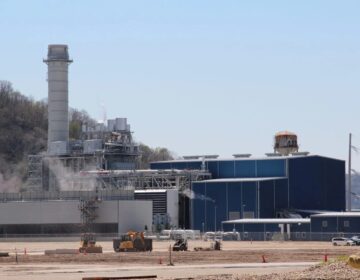Millions of federal dollars could help Pa. build a climate-ready electric grid
PECO, PPL Electric, and Duquesne Light’s plans include floodproofing, adding battery storage, and increasing grid capacity.

File photo: Energy Secretary Jennifer Granholm speaks at McKinstry Aug. 15, 2023, in Seattle. (AP Photo/Lindsey Wasson, File)
This story is part of the WHYY News Climate Desk, bringing you news and solutions for our changing region.
From the Poconos to the Jersey Shore to the mouth of the Delaware Bay, what do you want to know about climate change? What would you like us to cover? Get in touch.
The federal government has announced billions of dollars to prepare the country’s electric grid for the impacts of climate change and the clean energy transition.
Three of the 58 projects that could receive grants are in Pennsylvania.
“The grid, as it currently sits, is not equipped to handle all the new demand,” Secretary of Energy Jennifer Granholm told reporters on a press call this week. “We are on a mission to transform this grid.”
The country’s fragmented, largely outdated electric grid is considered a major obstacle to fighting human-caused climate change. Grid infrastructure faces increasing challenges as climate change drives more extreme weather. Transmission capacity will also need to grow significantly to accommodate new renewable energy projects.
This week, the U.S. Department of Energy announced up to $3.46 billion in grants for grid upgrade projects in 44 states, through its Grid Resilience and Innovation Partnerships Program. The money comes from the Bipartisan Infrastructure Law.
PECO, which serves Philadelphia and several of the surrounding counties, could get up to $100 million to move its substation equipment away from flood-prone areas, and create a microgrid with battery storage to replace a diesel generator at the utility’s storm response center.
“Leveraging this federal grant will … allow us to increase grid capacity to enable renewable energy, electric vehicle charging, and job growth in our region while minimizing the impact on customer bills,” PECO President and CEO Mike Innocenzo said in a statement this week.
PECO’s DOE grant would also help fund a PECO initiative to give money to Philly public schools for climate resilience, education, clean energy, and energy efficiency.
PPL Electric, which serves communities in more than two dozen counties in eastern Pennsylvania, could get nearly $50 million for new technology to automate its grid in order to predict failures, reduce outages, and improve resilience.
Duquesne Light in Pittsburgh could get close to $20 million to increase its transmission system capacity in order to “unlock additional clean energy generation.”
Much of the country’s grid infrastructure is outdated, with more than half of transmission lines and power transformers installed before 1970, White House advisor and infrastructure coordinator Mitch Landrieu said. This infrastructure must now contend with the impacts of climate change, like more intense heat waves, stronger storms, and bigger wildfires.
“Older equipment can overload during extreme heat and cold, when power is needed most,” Landrieu said. “It’s also more likely to fail when communities are washed out by historic floods and decimated by stronger storms. That means families and businesses can lose power for hours, days, or even weeks at a time — and that puts lives at risk.”
Outages can be especially dangerous for people who rely on electricity-dependent medical equipment, as well as during extreme heat and cold.
“Every time you turn on a light, charge your laptop, plug in an air conditioner, put leftovers in the fridge — you rely on the electric grid,” Landrieu said.
Demand on the grid is expected to grow as more parts of everyday life — like cars and home heaters — become electrified, and as air conditioning becomes more essential. Granholm said the grid needs to change in order to accommodate new clean energy generation and meet President Biden’s goal of 100% clean electricity by 2035.
“We need [the grid] to be bigger, we need it to be stronger, we need it to be smarter to bring all of these new projects online,” Granholm said.
The grants are not guaranteed. The utilities are in negotiations with DOE for the money, and DOE officials have said the agency may “cancel negotiations and rescind the selection for any reason during that time.”
Older equipment can overload during extreme heat and cold when power is needed most and it’s also more likely to fail when communities are washed out by historic floods and decimated by stronger storms.
The Department of Energy plans to invest a total of over $10 billion in grid upgrades nationwide.
WHYY is your source for fact-based, in-depth journalism and information. As a nonprofit organization, we rely on financial support from readers like you. Please give today.







